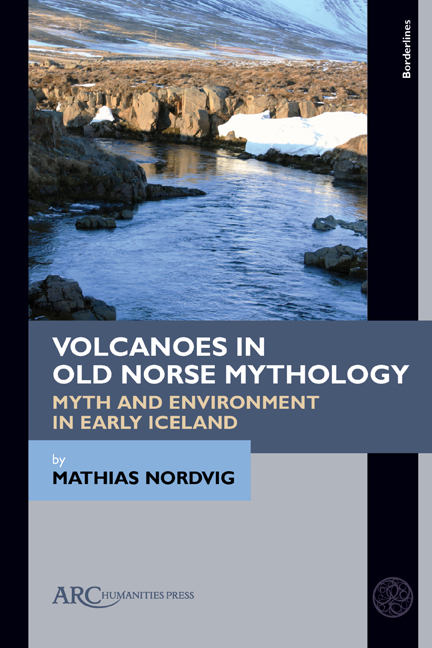Book contents
- Frontmatter
- Contents
- Introduction
- Chapter 1 Old Norse Mythology Between Environment and Literature
- Chapter 2 An Indigenous Theory of Volcanism in Iceland
- Chapter 3 Volcanism in Old Norse Cosmogony
- Chapter 4 Volcanoes in the Social Order of Old Norse Mythology
- Chapter 5 Volcanoes as a Cosmological Principle in Old Norse Mythology
- Bibliography
- Index
- Frontmatter
- Contents
- Introduction
- Chapter 1 Old Norse Mythology Between Environment and Literature
- Chapter 2 An Indigenous Theory of Volcanism in Iceland
- Chapter 3 Volcanism in Old Norse Cosmogony
- Chapter 4 Volcanoes in the Social Order of Old Norse Mythology
- Chapter 5 Volcanoes as a Cosmological Principle in Old Norse Mythology
- Bibliography
- Index
Summary
WHEN ICELAND WAS settled in the beginning of the ninth century, the migrating Scandinavians realized that the landscape was different from their places of origin. Their cultural background came primarily from pre-Christian Norway. Only a handful of them were Christian. This means that the majority of early Icelanders probably would have made sense of their new lands in context of pre-Christian Scandinavian mythology. If we are looking for early Icelandic conceptualizations of the environment, we should look towards Old Norse mythology in the Edda, in Eddic and skaldic poetry. Their perspective on the world did not fundamentally distinguish between nature and the human, in a spiritual sense. Our modern tendency to separate culture from nature has emerged with industrialization. This way of thinking about the world was only in its infancy in the medieval period, when Old Norse mythology was being written down. In Old Norse literature it is possible to detect two modes of thinking: one is based on an indigenous worldview, which can be characterized as holistic and integrative, another is based on the Latinate script-world that arrives with Christianity and establishes a new hierarchy of knowledge.
Snorri Sturluson's Edda is a treatment of oral indigenous knowledge about life in Iceland in the knowledge hierarchy of the Latinate script-world. On the one hand, it relies on older oral narration; on the other, it subordinates this narration to learned Christian philosophy. When its content is compared to similar indigenous narrations from other cultures, it is possible to discuss how early Icelanders conceptualized their environment through a coherent cosmology, which is tied to volcanism. I argue that the Edda is an expression of environment-based narration in early Iceland. It establishes a mythology based on cultural material from Scandinavia, and devises a cosmology complete with social structures, which has been impressed by the experience of volcanism. The creation myth refers social structures based on group competitiveness to primordial volcanic processes. This group competitiveness is replayed in multiple myths. In the mead myth, the Ragnarǫk myth, and the myth about Þórr duelling Hrungnir, the pattern is realized in volcanic contexts. This locates my analysis in the realm of geomythology.
- Type
- Chapter
- Information
- Volcanoes in Old Norse MythologyMyth and Environment in Early Iceland, pp. 1 - 4Publisher: Amsterdam University PressPrint publication year: 2021



